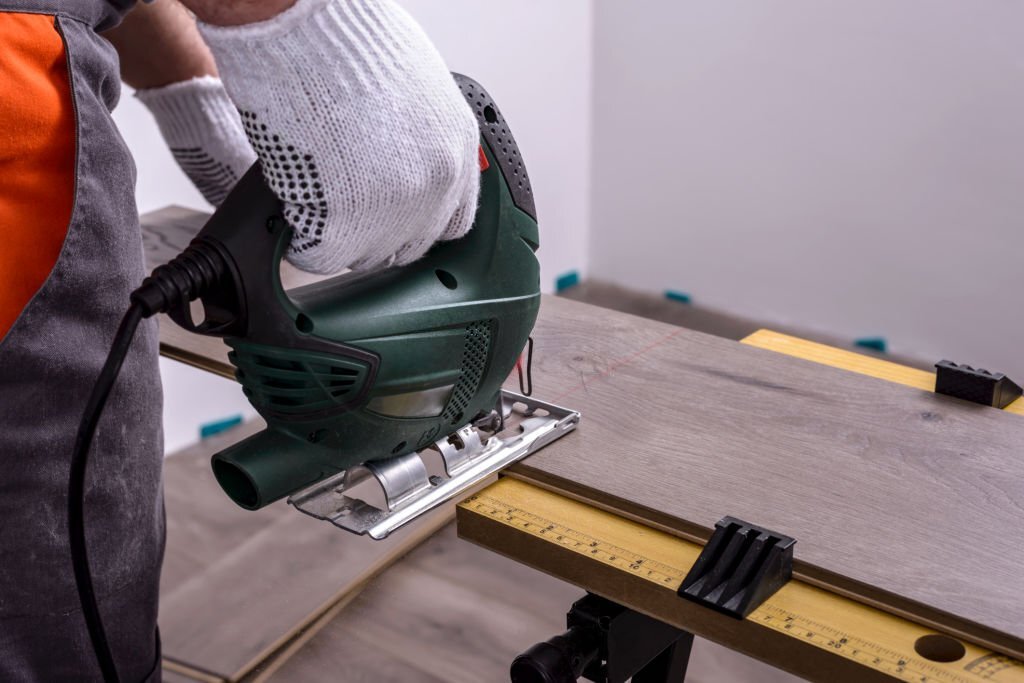Saws are widely loved by professionals as well as DIY enthusiasts. However, it is important to note that these extremely useful and powerful tools can turn into beastly monsters in no time if they are not handled with care and precaution.
Safety Tip for Using Saws With Laminate Flooring
Here’s what you need to take care of:
1 – Do not get into the path of the saw:
Saws are generally designed as free-hand saws. They have powerful motors with strong blades having an exceptional RPM. It is never advisable to put any part of your body in the path of a saw.
The best way to handle such a powerful tool is to make sure that your hand, arm, and elbow align to produce the best possible angle and are in a better position to handle kickbacks.
We’ve also written a detailed guide on how to cut laminate with a circular saw.
2 – Kerf and blade binding:
When a spinning blade receives a lot of pressure, it results in blade binding. As kerf is the safe bubble for the blade to spin, it keeps the blade where it is meant to be.
However, if you mess up and twist the saw while cutting, it may result in increased pressure building. This can result in extremely strong kickbacks and solid jerks.
Never twist a saw while working and try your level best to move it in a straight line with a firm grip.
3- Prop the piece:
Make sure to put some sacrificial pieces as a base under your actual piece. It will allow the saw to have a stable base without any fear of unintentional binding.
4- Blade depths:
Make sure to have less than a quarter inch of exposed saw blade going into the material. Anything more than that can result in material damage.
Apart from that, it unnecessarily creates more blade surfaces thereby increasing the chances of kickbacks during the process.
5- Saw adjustments:
It has been observed that several DIY enthusiasts do not mind adjusting their saws with their blades still spinning. To change their blade depth they simply release the lever and swivel the base plate.
Making plunge cuts like that is not safe at all and may cause serious damage to the tool, the person handling it and the laminate flooring as well.
6- Retracting a spinning blade:
Usually, seasoned carpenters are always in a rush to get the job done. To be honest they can pretty much retract the blade while it is still spinning to a great degree of perfection.
However, it is strictly recommended not to retract a spinning blade if you are an amateur worker or DIY enthusiast. Spare some extra seconds at hand and let the spinning blade come to rest before retracting it.
Apart from solid kickbacks, retracting a spinning blade may ruin the whole cut for you by leaving nicks in the material.
7- Blade guard removal
Some people find it easy to push the blade guard and pin it back in that position for uninterrupted and miraculously fast cutting.
Remember that it’s built for a reason, it guards you and your tools against any unpleasant incident. So do not try to alter the tool functions just to save a few minutes.
8- Setting a saw blade
Once you are done with work, take a moment to make sure that blade is not spinning and then let it down on a surface.
It is highly recommended to check that guard sprung back and that it has completely come to the rest (wind down) before you put it down on a table.
9- Starting up with contact
You should always retract a blade before you start and then slightly move towards your point of contact. It prevents all types of nicking and other material damage etc.
10- Cord drag
If you aim to go for longer cuts, you are liable to make a mess with power sources, cable extensions, etc. It will certainly reach its maximum point of length and after that saw will be unable to move. ù
In such a position, the blade comes under immense pressure and there are increased chances of the blade getting twisted.
So, while going for longer cuts, try to hold the wire in your side/free hand so it may not cause any obstruction in the cutting.
11- Trigger discipline
Do not pull the trigger until you are 100% ready to cut the surface. Establish a firm grip on the tool, make sure you have tick marked all the precautions, and then pull the trigger.
Once you are done with cuts, take your finger off the trigger, let it wind down, and then set down the saw.
These were some of the most common mistakes done by handlers while working with saws. It is important to consider that these power tools are extremely dangerous and must never be operated without proper guidance.
Any reckless handling of the tool is guaranteed to result in an unpleasant accident at the workstation. So make sure to take all the precautions and bear these safety tips in your mind before you touch your saw for laminate flooring the next time. Obviously safety over everything!

Meet Max, the founder and lead writer of our home improvement blog. He is a seasoned home renovation and design expert with over 8 years of experience in the industry.
Max has a passion for creating beautiful and functional living spaces and is dedicated to helping homeowners and DIY enthusiasts achieve their home improvement goals. He has worked on a wide range of projects, from small updates to full-scale renovations, and has a wealth of knowledge and experience to share.
As an avid DIYer, Max understands the challenges and rewards of tackling a home improvement project and enjoys sharing his tips, tricks and insights to make the process as easy and enjoyable as possible. In his free time, Max can be found working on his own home renovation projects, reading design blogs and magazines, and travelling to explore new design trends.
Max is excited to share his knowledge and experience with you and hopes to inspire and empower you to take on your next home improvement project with confidence. Follow Max on LinkedIn for more inspiration and expert advice.


